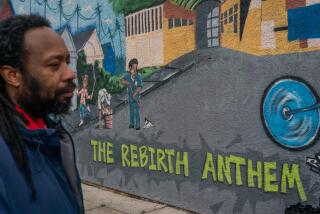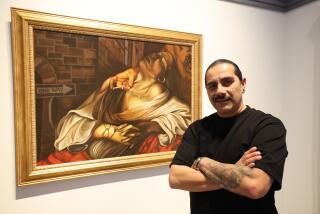An uncertain future for a grace note in the urban streetscape
I asked the gangbangers of Highland Park to stay away from the Jesus wall. That was 15 years ago. I never had to ask again.
Anyone who commutes on the Arroyo Seco Parkway knows the wall I’m talking about — the long stucco shed on the west side of the freeway, across the Arroyo from Heritage Square.
Sometime in the 1990s, an amateur muralist painted it with the simple message: “JESUS SET ME FREE.”
The words stood out on a sky-blue background framing an image of a white dove being released by two hands.
Before the mural appeared, the wall had been a canvas for street hoods who seemed to come every night to scrawl their monikers on top of someone else’s. They added layer after layer of illegible marks.
So, I took notice when the Jesus mural appeared, and the graffiti didn’t return. I assumed the Christian message held a power over the taggers that the threat of arrest did not.
I first wrote about the wall in 1999 when its power had waned. First the blue background faded, then the stucco beneath it began to flake.
One night, a tagger put his mark on it. The spell was broken. The wall quickly degenerated again into a bulletin board for the cryptic messages of turf control.
A few months after I wrote about the desecration, the wall began to change again. First the stucco flakes were scraped away. Later a fresh blue background appeared. Next the words “JESUS SET ME FREE” were blocked out in outlines.
The man who lived in the house behind the shed put me in touch with the artist, a young man named Ricardo Ochoa. He had a day job in a phone company call center and worked on the mural on weekends.
Watching Ochoa do his work one Sunday, I unexpectedly became a part of the Jesus wall. Ochoa said he needed a model for the hands. He posed mine for a Polaroid shot.
For 15 years, I’ve admired the mural on my way to work each day, always refreshed by the simplicity and sophistication of its message — at once a declaration and a supplication.
Ochoa had told me it was only an artistic theme rather than a statement of his personal redemption. I concluded, instead, that its power was in giving voice to the wall itself. The words and image were the wall’s salvation.
“Those are my hands,” I’ve said to countless out-of-town guests.
Earlier this year, I noticed a gang name on the wall, small but unmistakable. For a few days I waited for the retaliation. It didn’t come.
Was this infraction the work of a newbie who didn’t know, or refused to play by, the rules? Or was it an unbeliever who saw no meaning in the message?
And were the veterans so pious that they could turn the other cheek and not respond?
I was sure the tension would break one day and the Jesus wall would once again revert to a wall of Babel.
Instead, one day, the new graffiti was gone, replaced by a patch of blue paint.
The cycle repeated a few times, new graffiti, new patch of paint. Somehow the hands and the dove have been spared. But the mural itself is in danger.
The patches, too deep a blue, are done by a painter, not an artist.
Hoping to again connect with Ochoa, I went to the property Saturday to knock on doors. It’s a ramshackle complex. An aging two-story apartment on the corner has a wide foyer and a grand wood staircase. No one there knew anything about the mural.
A woman living with three dogs in the stucco house behind the shed said the artist was long gone, and the property owner was taking care of the wall.
She said she didn’t know how to reach him.
Real estate records led me to a pleasant house on a Highland Park hilltop with a view of the Monterey Hills.
Albert Balderrama, 83, spoke to me briefly from his barred porch.
He’s a retired LAPD detective. He dabbled in real estate while working the 77th Division decades ago.
He bought and sold a few properties, but kept the one at the corner of Avenue 39 and Carlota Boulevard.
“I always liked that one,” he said.
He was told by the seller that the two-story apartment was once the Beverly Hills home of actor John Barrymore. A speculator bought it and moved it to its current location, where it is a derelict counterpoint to the Victorian structures that have been moved to the opposite bank and restored.
Balderrama said the graffiti epidemic of the 1980s led him to seek one of the many muralists of the era who were always on the lookout for a wall on which to publish their work.
He wanted a religious theme, he said, not out of personal devotion, but thinking it would be the most effective deterrent.
He’s lost touch with the artist too. Whenever he notices new graffiti, he calls his Guatemalan painter, Leopoldo, to touch it up.
And that is where the story stands.
The last time I looked a new script was written over the blue touch-up paint: “Muerto.”
It was an ominous sign and filled me with pessimism about what will happen next.
In our city nothing is immutable. Art, reverence and tranquillity vanish as unpredictably as they arise.
The rhythm of urban life continues. The battle now is between Leopoldo and Muerto. I can’t see which way it will go.
I pray that my hands will be safe.
More to Read
Start your day right
Sign up for Essential California for news, features and recommendations from the L.A. Times and beyond in your inbox six days a week.
You may occasionally receive promotional content from the Los Angeles Times.







